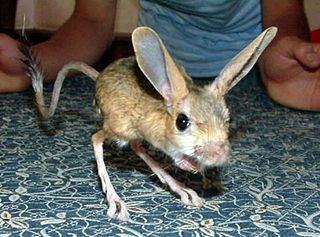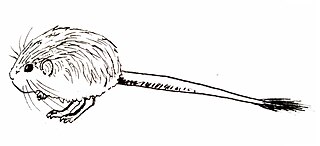
Jerboas are hopping desert rodents found throughout Arabia, Northern Africa and Asia. Jerboas form the bulk of the membership of the family Dipodidae. They tend to live in hot deserts.

The Dipodidae, or dipodids, are a family of rodents found across the Northern Hemisphere, the sole family in the superfamily Dipodoidea. This family includes over 50 species among the 16 genera. They include the jerboas, jumping mice, and birch mice. Different species are found in grassland, deserts, and forests. They are all capable of saltation, a feature that is most highly evolved in the desert-dwelling jerboas.

The four-toed jerboa is a rodent of the family Dipodidae and genus Allactaga that has four digits. It is the sole species in the subgenus Scarturus. Four-toed jerboas are native to Egypt and Libya. They live in coastal salt marshes and dry deserts.

The Mongolian five-toed jerboa or Siberian jerboa is a species of rodent in the family Dipodidae. It is found in China, Kazakhstan, Mongolia, and Turkmenistan.
Bobrinski's jerboa is a species of rodent in the family Dipodidae. It is monotypic within the genus Allactodipus. It is found in Turkmenistan and Uzbekistan.

The five-toed pygmy jerboa is a species of rodent in the family Dipodidae. It is monotypic within the genus Cardiocranius. It is found in China, Kazakhstan, and Mongolia.
Lichtenstein's jerboa is a species of rodent in the family Dipodidae. It is monotypic within the genus Eremodipus. It is found in Kazakhstan, Turkmenistan, and Uzbekistan.

The greater Egyptian jerboa is a species of rodent in the family Dipodidae. It is found in Algeria, Egypt, Libya, Morocco, Saudi Arabia, Tunisia, and is possibly extinct in the Negev Desert of Israel. Its natural habitats are subtropical or tropical dry shrubland, sandy shores, and arable land.
Pygeretmus is a genus of rodent in the family Dipodidae. It contains the following species:
The dwarf fat-tailed jerboa is a species of rodent in the family Dipodidae. It is found in China, Iran, Kazakhstan, Mongolia, and Russia. They mostly reside in desert environments which can explain their size. They go long periods of time without food and water, which means they need a lower metabolic rate, and can be a reason for their size.

The thick-tailed pygmy jerboa is a species of rodent in the family Dipodidae. It is found in China, Kazakhstan, and Mongolia. Its natural habitats are temperate grassland and temperate desert. It is threatened by habitat loss. It is listed by the IUCN as being "least concern".
Salpingotus is a genus of rodent in the family Dipodidae. It contains the following species:
Kozlov's pygmy jerboa is a species of rodent in the family Dipodidae. It is found in northwestern China and southern and eastern Mongolia. Its natural habitat is temperate desert.

The pale pygmy jerboa or pallid pygmy jerboa is a species of rodent in the family Dipodidae endemic to Kazakhstan.
The Kluchor birch mouse is a species of rodent in the family Dipodidae. It is endemic to Russia. Its natural habitat is temperate forests.
The gray birch mouse is a species of rodent in the family Dipodidae. It is endemic to Kazakhstan. Its natural habitat is temperate forests.
Strand's birch mouse is a species of rodent in the family Dipodidae. It is endemic to Russia.

Cardiocraniinae is a subfamily of rodents in the family Dipodidae, named by the Russian zoologist Boris Stepanovich Vinogradov (1891–1958) in 1925. These jumping rodents are small mammals, less than 20 cm long.







